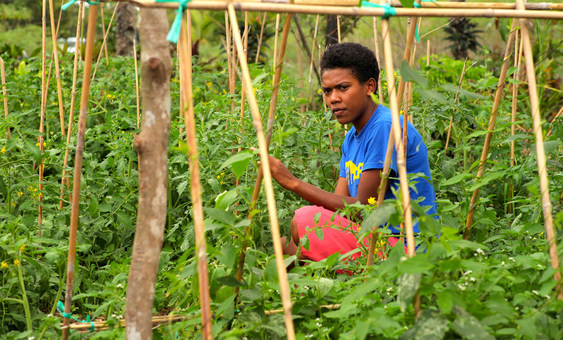UN commits to help Pacific island agriculture adapt and survive climate crisis
The UN’s Food and Agriculture Organization (FAO) pledged on Friday to work hand in hand with the people of the Pacific to improve nutrition, and mitigate the worst effects of climate change, which pose an existential threat to many island nations across the region.
The commitment came at a joint meeting of Pacific Ministers of Agriculture and Forestry, as part of the Pacific Week of Agriculture being held in Samoa, convened jointly by FAO and the Pacific Community (SPC).
Many Pacific island countries, and Small Island Developing States (SIDS) around the world, are disproportionately threatened by climate change and the impacts of severe weather events, says FAO, a point driven home during last week’s landmark summit on SIDS and the unique challenges they face, at UN Headquarters in New York.
Coupled with the vulnerability to rising sea levels and crippling extreme weather events, the small size and isolation of many Pacific island communities has also led to unhealthy diets though an increasing reliance on imported, processed foods.
Many of these foods are high in fat, sugar and salt, leading to a crisis of obesity. The Pacific region is home to all the countries ranked in the top ten highest obesity rates globally, and it has the highest prevalence of diabetes per capita, FAO notes.
“While responding to obesity is a big challenge, the prevalence of stunting in children under-five in the Pacific is also a major concern. It is running at almost 40 percent, the highest rate of any subregion in Asia and the Pacific,” said Kundhavi Kadiresan, FAO Assistant Director-General and Regional Representative for Asia and the Pacific.
“Globally, the prevalence of undernourishment is around 17.5 percent in SIDS countries, compared to a worldwide average of around 11 percent,” she added in her opening remarks to Ministers.
Working towards 2030
The region has made progress in implementing an action programme on food security and nutrition, but much more will need to be achieved if the Pacific Islands are to meet the 2030 Sustainable Development Goals.
“This is real progress, but what is still needed is a paradigm shift to accelerate actions and achieve real impact on the nutrition front and in responding to the threats of climate change in the Pacific,” Ms. Kadiresan said, noting that FAO outlined a new initiative last week that matches the least developed SIDS – those with the highest rates of hunger and poverty – together with developed countries.
“The ‘Hand-in-Hand Initiative’ will reach out to a wide range of partners including governments, the private sector, global foundations and others.”
The meeting heard how a multi-pronged approach could put modern technology and new innovations into the hands of small scale farmers, alongside an effort to rediscover healthy, locally produced foods that will improve diets and lower the reliance on imported, processed foods.
“Re-invigorating and re-establishing production of some of the healthier and naturally available local foods is a win-win approach. After all, generations of Pacific Islanders who farmed the lands and harvested fish from the sea knew what they were doing”, exclaimed Ms. Kadiresan.
“They were providing nutritious foods for their families and maintaining livelihoods that were passed father-to-son, mother-to-daughter, father-to-daughter and so on…Today we call these ‘food systems and value chains’. The names might have changed, but the sensibilities have not.”

